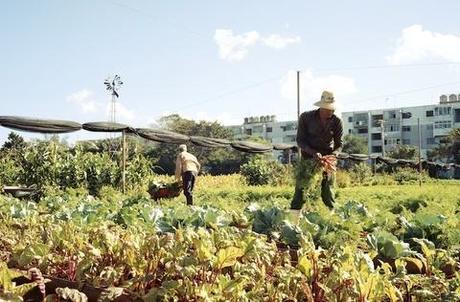
Farming Cuba: Carrot Harvest
At the Vivero Alamar organopónico in Havana, growers harvest carrots that have been grown without pesticides or herbicides, instead using compost tea, mushroom rhizomes, artisanal pest control products, and permaculture strategies such as intercropping.
Photo provided by Carey Clouse
The cornucopia is overwhelming, even overflowing. Sugarcane growing in vacant lots, rabbits and chickens rooting around on rooftops, goats pacing around median strips, coffee, mangoes, avocados, and fruit trees growing in city parks. Havana’s urban harvest is as impressive as the sheer number of people farming within the Cuban capital. In a city of two million people, more than 87,000 acres are dedicated to urban agriculture and “organopónicos,” a system of urban organic gardens.
According to Carey Clouse, author of Farming Cuba: Urban Agriculture from the Ground Up (Princeton Architectural Press), she was overwhelmed by the magnitude of Cubans working the soil.
“It’s all over Cuba,” she says. “ I was amazed by the amount of urban agriculture. They were growing on every imaginable surface: playgrounds, rooftops, public spaces. You can ride your bike and rollerblade through a park, and one second you’re in a classic recreational space, and the next moment, you’re in farm in the middle of the city.”
The collapse of the Soviet Union in 1989, which caused a supply shortage that economically rocked the island nation, was the catalyst for the growth of urban farming, according to Clouse, and made the nation much more agriculturally productive. The resulting shortage of food, fertilizer, and seed decimated the agricultural sector and caused a food crisis. A command economy that always provided suddenly lacked the resources to do so—on average, Cuban adults lost 20 pounds during the so-called “special period.” Everyday Cubans filled in the gaps with their own plants and plots (organic, in most cases, since a shortage of petroleum removed the raw materials for commercial fertilizer). Havana, which Clouse says resembles New Orleans, suddenly found itself as a juxtaposition: high-rise towers and dense apartments contrasting with rows of plants and private plots.
“These enterprising growers took care of themselves and created a totally ground-up movement in 1990 and 1991,” says Clouse. “There was a lot of space hijacking in the early ‘90s. By 1993, the government recognized that it works, realized it was a reasonable way to use public land, and now it provides really important support, like the way some of the WPA programs worked.”
Now, 75% of the produce consumed in Havana is grown in the city, and since growers and farmers can sell their wares in a quasi-free market, they tend to make double what a normal citizen makes. The Cuban support structure for urban agriculture would make anyone in an American city prepping for their backyard garden jealous. Urban agriculture is part of Havana’s official master plan, and farms are often located prominently in major parks. The state provides free land to farmers and subsidizes access to tool, seeds, starts and planting material. Havana alone boasts 40 urban veterinary clinics for those raising livestock, and 52 agricultural support stores to provide advice and services to farmers.
Clouse sees a lot of parallels between Havana and cities such as Detroit. “In many American cities, there are all of these enterprising growers who are creating CSAs and growing their own food, but they just can’t do it on the scale of Cuba without government support,” she says. “Granted, in Cuba, the government owns all the land, and you need the approval of the state. But in the States, the challenge is, can we scale up? Can we take over medians, or perhaps vacant land in the cities?”
With her book, Clouse really wants to dig into the design implications of urban farming in Cuba. Vacant lots in Havana and Detroit are very similar—how they can both be best utilized to provide affordable food and leave a small carbon footprint? Can rooftop animal husbandry in Cuba be adapted to New York or San Francisco?
“I’m interested in the formal aspects of design, the materials, orientation of the beds, the signage, market stands and the use of permaculture techniques in the city,” she says. “All these questions that designers are grappling with in the United States have been answered already in Havana, many times using the same types of technology.”
